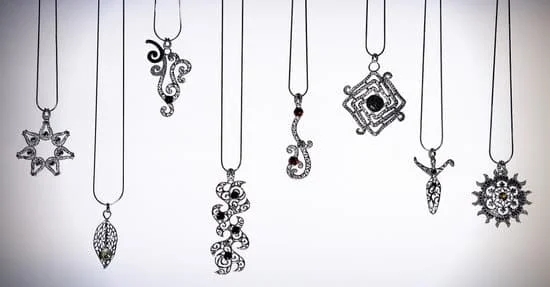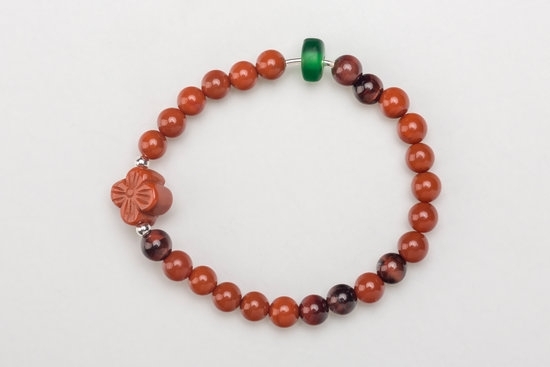The history of mosaic glass jewelry dates back to ancient times, with its origins rooted in the craftsmanship and artistry of early civilizations. This section will delve into the rich history and evolution of mosaic glass jewelry, from its ancient origins to its resurgence in contemporary fashion. By exploring the techniques, materials, and cultural significance of this exquisite art form, we can gain a deeper understanding of its enduring legacy.
Throughout history, mosaic glass jewelry has captivated and adorned individuals across different cultures and eras. From ancient origins to modern evolution, the intricate craftsmanship and symbolic meaning behind these pieces have continued to fascinate both artisans and enthusiasts alike.
In this article, we will trace the beginnings of mosaic glass jewelry from its ancient origins and explore how it flourished in ancient Rome. We will also examine its presence in the Byzantine Empire during the medieval era and its resurgent popularity during medieval and Renaissance Europe.
Additionally, we will discuss how mosaic glass jewelry has evolved in contemporary fashion, along with the techniques, materials, symbolism, and meaning behind these stunning pieces. Join us on this journey as we reflect on the enduring legacy of mosaic glass jewelry.
Ancient Origins
Mosaic glass jewelry has a rich and fascinating history that dates back to ancient times. The origins of this exquisite art form can be traced to the ancient civilizations of Egypt and Mesopotamia. It is believed that the earliest forms of mosaic glass jewelry were created as early as 3000 BCE, with artisans using small pieces of colored glass to adorn themselves and create decorative items.
To create mosaic glass jewelry, ancient artisans would carefully shape individual pieces of colored glass, known as tesserae, and arrange them into intricate patterns or designs. These tesserae were then fused together using heat, resulting in stunning pieces of jewelry that showcased vibrant colors and elaborate motifs.
The art of creating mosaic glass jewelry continued to evolve throughout the ancient world, spreading to regions such as Greece and Rome. In fact, it was during the Roman Empire that mosaic glass jewelry reached new heights of popularity and craftsmanship. Roman artisans perfected the techniques of fusing glass tesserae to create elaborate mosaics, which were used not only in jewelry but also in architectural decoration and other luxury items.
The popularity and influence of mosaic glass jewelry continued to grow throughout the ancient world, with each civilization adding its own unique style and techniques to the craft. It is truly remarkable to see how this ancient art form has endured over thousands of years, leaving behind a legacy that continues to inspire contemporary designers and artisans today.
The Roman Influence
Ancient Rome was a hub of innovation and creativity, and this was especially apparent in the realm of jewelry-making. The Roman influence on the history of mosaic glass jewelry is undeniable, as it was during this era that the craft truly flourished and reached new heights of artistry and craftsmanship.
Technological Advancements
One of the key factors behind the flourishing of mosaic glass jewelry in ancient Rome was the technological advancements in glassmaking. Roman artisans perfected the art of creating intricate mosaics by fusing together small pieces of colored glass, resulting in stunning and elaborate designs that were unparalleled at the time.
Royal Patrons and Elite Status
The popularity of mosaic glass jewelry in ancient Rome can also be attributed to the patronage of royalty and elite members of society. Emperors, empresses, senators, and other high-ranking individuals commissioned elaborate pieces of mosaic glass jewelry to showcase their wealth, status, and taste for luxury. This further elevated the craft and encouraged more artisans to specialize in this intricate form of adornment.
Legacy and Influence
The legacy of Roman mosaic glass jewelry can still be seen today in museums around the world. The exquisite pieces that have survived throughout history serve as a testament to the skill and artistry of ancient Roman artisans.
Additionally, the influence of Roman mosaic glass jewelry can be observed in contemporary jewelry design, with modern artisans drawing inspiration from these ancient techniques and styles to create new and innovative pieces. The enduring legacy of Roman mosaic glass jewelry continues to inspire artists and fascinate enthusiasts, cementing its place in both historical significance and contemporary relevance.
Medieval Revival
The Byzantine Empire played a significant role in the history of mosaic glass jewelry, particularly during the medieval period. The art of crafting intricate mosaic glass jewelry experienced a revival during this time, as the empire embraced and further developed the techniques and styles of this ancient craft.
One notable aspect of mosaic glass jewelry in the Byzantine Empire was its use in religious and ceremonial contexts. Intricately designed pieces were often used to adorn religious relics, icons, and important figures within the church. The use of vibrant colored glass in these pieces symbolized spiritual significance and added to the grandeur of religious ceremonies.
Another important contribution of the Byzantine Empire to mosaic glass jewelry was the development of more advanced techniques for creating complex designs. Skilled artisans experimented with different methods of fusing together small pieces of colored glass to create elaborate patterns and motifs, pushing the boundaries of what could be achieved with mosaic glass jewelry.
The influence of Byzantine mosaic glass jewelry extended beyond the empire’s borders, with neighboring regions adopting and adapting these artistic traditions. This exchange of ideas and techniques contributed to a rich and diverse range of styles within mosaic glass jewelry, making it an enduring symbol of cultural exchange and innovation throughout history.
| Byzantine Empire Contributions | Significance |
|---|---|
| Use in religious and ceremonial contexts | Symbols spiritual significance, adds grandeur to ceremonies |
| Advancements in crafting techniques | Development of more complex designs |
| Influence on neighboring regions | Contribution to rich and diverse styles within mosaic glass jewelry |
Renaissance Resurgence
During the Medieval and Renaissance periods in Europe, mosaic glass jewelry experienced a revival in popularity and artistic innovation. This period saw a renewed interest in the ancient art of crafting mosaic glass pieces, with skilled artisans creating intricate and ornate designs that were highly prized by the wealthy elite.
The resurgence of mosaic glass jewelry during this time was influenced by a combination of factors, including trade with the Byzantine Empire, increased access to precious materials, and a growing appreciation for the aesthetic beauty of these stunning works of art.
One of the defining characteristics of mosaic glass jewelry from this era is its use of vibrant colors and intricate patterns. Artisans employed a variety of techniques, such as fusing together different colored glass rods to create elaborate designs or embedding small pieces of glass into metal settings to form intricate mosaics. These techniques allowed for the creation of visually striking jewelry pieces that were considered both luxurious and fashionable.
The popularity of mosaic glass jewelry during the Medieval and Renaissance periods was also intertwined with social and cultural influences. Wealthy patrons commissioned custom-made pieces that reflected their status and taste, while the symbolism behind certain designs held significant meaning within various societal contexts. As such, mosaic glass jewelry became not only an expression of artistic creativity but also a reflection of societal values and beliefs during this pivotal time in history.
Modern Evolution
Mosaic glass jewelry has experienced a modern evolution, finding its way into contemporary fashion and captivating the hearts of jewelry enthusiasts worldwide. This section will delve into the resurgence of mosaic glass jewelry in today’s fashion landscape, exploring how ancient techniques and designs are being adapted to suit modern tastes and styles.
Revival of Ancient Techniques
In recent years, there has been a growing interest in reviving traditional crafts and techniques, including the art of creating mosaic glass jewelry. Artisans and designers are rediscovering ancient methods of glassmaking and mosaic work, drawing inspiration from historical pieces to create new and innovative designs. By incorporating these age-old techniques into their creations, contemporary jewelers are able to infuse their pieces with a sense of history and tradition, appealing to those who appreciate the craftsmanship of bygone eras.
Contemporary Designs and Styles
While staying true to the traditional techniques of mosaic glass jewelry making, modern artisans are also introducing fresh designs and styles that cater to today’s fashion trends. From statement necklaces featuring bold, geometric patterns to delicate earrings with intricate floral motifs, contemporary mosaic glass jewelry offers a diverse range of styles to suit different tastes and occasions.
By combining ancient craftsmanship with modern aesthetics, these pieces have become sought-after accessories for those looking to make a unique style statement.
Popularity in Fashion Circles
The resurgence of mosaic glass jewelry has not gone unnoticed in the world of fashion. Celebrities, influencers, and fashionistas have been spotted wearing these distinctive pieces at red carpet events, galas, and high-profile gatherings.
As a result, there has been a renewed appreciation for the beauty and artistry of mosaic glass jewelry among trendsetters and tastemakers. This newfound popularity has also led to collaborations between renowned designers and skilled artisans, further cementing the place of mosaic glass jewelry in contemporary fashion.
Techniques and Materials
Mosaic glass jewelry has a rich history dating back to ancient times, and its craftsmanship has evolved over the centuries. The techniques and materials used in creating mosaic glass jewelry have been integral to its stunning beauty and enduring appeal. From ancient origins to modern evolution, the craftsmanship of mosaic glass jewelry has continued to captivate artisans and enthusiasts alike.
In the early days of mosaic glass jewelry, artisans utilized a range of techniques to create intricate designs. One such technique is known as millefiori, which involves layering colored glass rods to form patterned canes that are then sliced to reveal the design. Another technique is tesserae, where small pieces of glass, called tesserae, are carefully arranged to form a larger design. These time-honored techniques require precision and skill, resulting in breathtaking pieces of jewelry.
The materials used in creating mosaic glass jewelry have also varied throughout history. In ancient times, artisans relied on naturally occurring materials such as sand, plant ash, and metal oxides to create vibrant colors for their glass pieces. Today, modern artisans have access to a wider array of synthetic materials and advanced tools that allow for greater creativity and precision in their work. Despite these advancements, many contemporary craftsmen still honor the traditional methods of creating mosaic glass jewelry.
Whether it’s through the careful arrangement of tesserae or the meticulous process of creating millefiori canes, the craftsmanship of mosaic glass jewelry continues to be a testament to human creativity and ingenuity. As we continue to explore the rich history of this art form, we gain a deeper appreciation for the skill and dedication required to produce these exquisite pieces that have stood the test of time.
Cultural Significance
Mosaic glass jewelry holds a deep cultural significance, with symbolism and meaning that have evolved over centuries. Throughout history, mosaic glass jewelry has been more than just a beautiful accessory; it has carried substantial cultural and religious significance for different civilizations and societies. From ancient times to the present day, the use of colors, patterns, and materials in mosaic glass jewelry has conveyed powerful messages and held important symbolism for various cultures.
In ancient times, mosaic glass jewelry was not only worn for aesthetic purposes but also served as a form of protection or as an indicator of social status. The use of specific colors and patterns in the creation of these pieces often represented specific beliefs, traditions, or even societal roles. In some cultures, certain colors were believed to have protective qualities or spiritual significance, while particular patterns were associated with luck, strength, or purity.
Throughout the medieval period and into the Renaissance era, mosaic glass jewelry continued to carry significant symbolism. This type of jewelry was often used to convey messages about faith, love, loyalty, or political allegiance. The intricate designs and meticulous craftsmanship of these pieces allowed wearers to express their personal beliefs and identities through their choice of jewelry.
In contemporary times, mosaic glass jewelry continues to hold cultural significance as it serves as a means of connecting individuals with their heritage or expressing solidarity with specific causes or movements. While modern designs may differ from those of ancient times, the symbolic meaning behind specific colors or patterns in mosaic glass jewelry remains an essential aspect of its cultural significance.
Conclusion
As we have traced the history of mosaic glass jewelry, it becomes evident that this art form has endured through the ages, leaving a lasting legacy in the world of craftsmanship and fashion. From its ancient origins to its modern evolution, mosaic glass jewelry has continued to captivate and inspire both artisans and admirers alike.
The techniques and materials used in creating these intricate pieces have evolved over time, yet they still hold true to the essence of their cultural significance and symbolism.
Throughout the Roman Empire, mosaic glass jewelry flourished, showcasing exquisite designs and intricate patterns that reflected the opulence and wealth of that era. As we moved into the Byzantine Empire, mosaic glass jewelry continued to be cherished and adorned by royalty, embodying a sense of prestige and sophistication. In medieval and Renaissance Europe, these timeless pieces experienced a resurgence in popularity, with craftsmen honing their skills to create breathtaking works of art.
Today, mosaic glass jewelry continues to thrive in contemporary fashion, blending tradition with innovation as modern artisans push the boundaries of creativity. While trends may come and go, the enduring legacy of mosaic glass jewelry remains a testament to its timeless appeal.
Its cultural significance transcends time, reflecting not only an appreciation for exquisite craftsmanship but also a reverence for history and tradition. In conclusion, the story of mosaic glass jewelry is one that continues to captivate us with its beauty and artistry.
Frequently Asked Questions
What Is the History of Mosaic Jewelry?
Mosaic jewelry has a rich history dating back to ancient civilizations such as the Romans and Greeks. These cultures used tiny pieces of colored stones, glass, or enamel to create intricate mosaic designs on jewelry.
What Is the History of Glass Mosaics?
The history of glass mosaics can be traced back to Mesopotamia around 3000 BCE. It spread throughout the Roman Empire, where it was used to decorate floors, walls, and ceilings in grand buildings and wealthy homes.
How Do You Date Micro Mosaic Jewelry?
Dating micro mosaic jewelry can be challenging but there are certain characteristics that can help determine its age. Examining the style, materials used, and the techniques employed in creating the piece can provide clues to its age and origin.

Welcome to my jewelry blog! My name is Sarah and I am the owner of this blog.
I love making jewelry and sharing my creations with others.
So whether you’re someone who loves wearing jewelry yourself or simply enjoys learning about it, be sure to check out my blog for insightful posts on everything related to this exciting topic!





